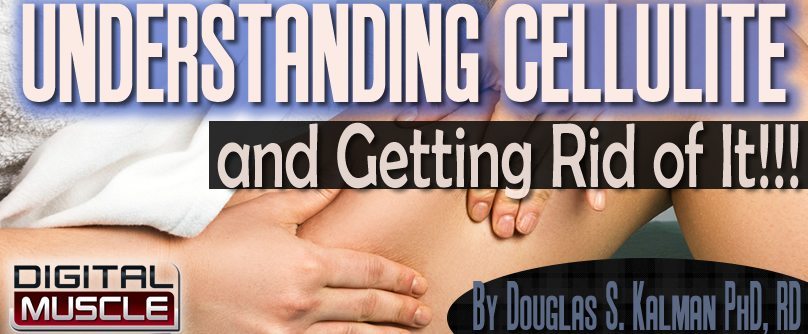Cellulite. For some, just the thought of it is a nightmare. I’m sure most women at one time or another have wondered if their legs or rear end would ever be plagued by the dreaded “lumpy-bumpy” dimpling that often strikes women as they age. A once-used term for cellulite was Gynoid lipodystrophy, or “G.D.,” which sounds a whole lot worse than cellulite—but, then, I don’t have it. (Believe it or not, some men do, although it’s rare.) If you’re a woman who’s starting to see some “cottage cheese” skin, you may have contemplated doing something about it. Let’s review some commonly used methods for fighting cellulite and talk about what works, what doesn’t, and what the future may hold.
A Cellulite Primer
The outer skin is separated from the muscle by a layer of fat that typically protects vital organs and is a natural blanket against the cold. The fat layer is not strong, and in turn it is bound tight by connective tissue called fascia that lies between the fat and the muscle. Fingerlike extensions of the fascia seep through the fat to the skin in order to keep the skin from sagging and hold it together.
In women, the fascia extensions are few and far between, compared to men, who have a tighter and much thicker architecture. As a result, women’s skin tends to sag, and selected fat pads push through, leading to cellulite.
According to Aaron Stone, MD, a well-known Los Angeles plastic surgeon, there are three possible causes of cellulite:
- A swelling of the skin and fat due to increased water retention.
- An overcontraction, or pulling, of the muscle on the fingerlike extensions of fascia, making the skin pitted, a.k.a. the dimpled look.
- A falling of the skin and fat with no change in the fingerlike extensions. It is easily aggravated by changes in bodyweight, particularly the up-and-down “yo-yo syndrome” that chronic dieters experience.
Further, Dr. Stone cites three levels of cellulite severity:
Level 1 is where you pinch your skin and see surface dimpling.
Level 2 is where you can see cellulite when you’re standing.
Level 3 is where you can see cellulite whether you’re standing or sitting.
So you can actually test yourself. You can pinch your thigh, pinch your hamstring, pinch your glutes and do the sitting and standing tests in front of a good mirror. Once you know the extent of the problem, you can determine the best treatment for you.
Are There Other Possible Causes?
Can it be hormones? According to some specialists and marketers of anti-cellulite products, estrogen, especially “excess estrogen,” may “soften” the connective tissue that anchors the skin to the muscle, weaving through the subcutaneous layer of fat, leading to a weakening of the fingerlike extensions and, eventually, cellulite. The problem can be made worse if you suffer from poor lymphatic flow. As the lymph glands and system help circulate fat throughout the body, poor lymph flow may result in swelling that stretches the connective fibers, allowing cellulite to form. Still, I don’t recommend using medications or dietary supplements that are purported to reduce estrogen. They have never panned out for cellulite reduction. Exercise, on the other hand, enhances skin tautness and lymph circulation. So put exercise at your top anti-cellulite to-do list.
Is it about diet? For decades, everyone from doctors to Avon ladies to your Aunt Betty blamed poor diet as the root cause of cellulite. Is there any truth to that? Losing weight can be an effective tool for reducing the appearance of cellulite for someone who is overweight; however, weight loss itself cannot wipe the cellulite away. In fact, it has to be combined with exercise and spot-specific exercise to have the best effect.
In a study of women conducted by Wayne Wescott, PhD, a simple whole-body resistance-exercise routine, coupled with mild aerobics and stretching, reduced cellulite, resulting in a 70 percent improvement. The researchers noted that the subjects had smoother, firmer legs, in addition to dropping weight and size.
So, What Works?
While we live in a society that values a quick fix, in this case, it’s not the best way to go. Here’s a rundown of some popular methods.
Pills. Lawrence Birnbaum, MD, of the Beverly Hills (California) Surgicenter, published the results of a study that examined the effectiveness of an herbal anti-cellulite pill as compared to the pill plus conjugated linoleic acid on skin appearance, thigh circumference and response rate. After 60 days of therapy, 75 percent of those receiving the combined treatment—with CLA—claimed it worked. In terms of real data, thigh circumference was reduced by 0.88 inches. The study concluded that a proper long-term placebo-controlled study was warranted.1
Two questions immediately come to mind: What is the name of the pill they took? And is less than an inch over two months really anything to scream home about?
Creams and lotions. Belgium, a hotbed of chocolate manufacturing, is also a hotbed of anti-cellulite research. Researchers at the University of Liege Medical Center looked at whether topical retinal (as in Retin-A) could help relieve cellulite. Fifteen women between the ages of 26 and 44 who had requested liposuction to treat their cellulite agreed to give the six-month study a try first. The results indicated that topical retinal, as compared to a placebo cream, increased skin elasticity by 10.7 percent and decreased viscosity by 15.8 percent. In places where the subjects’ skin had a “mattress look,” they got some benefit; however, their lumpy-bumpy spots had little or no response to the treatment. The authors concluded that retinal cream may indirectly improve cellulite by tightening the skin.2 As it was a longer study and showed some benefits, it led to growing number of retinal-based cellulite-reduction products coming on the market.
As a follow-up to the Belgian study, scientists at a different research laboratory looked at whether a cream containing caffeine, retinal and ruscogenine would help reduce cellulite in healthy adult women. They conducted a number of tests, comparing the cream to a placebo and evaluating the effects on circulation where the cellulite was present as well as cellulite reduction. Typically, with a placebo-controlled study, the participants do not know what they are getting and are told to use one cream on one leg and the other cream on the other leg. In this case, the product, which was made by Johnson & Johnson in France, enhanced circulation in the skin as well as reducing the cottage cheese look.3
In the mid-1980s, Drs. Greenway and Bray, obesity specialists, conducted a series of studies on whether creams made with aminophylline, a commonly used asthma medication, would help reduce the appearance of cellulite. The results showed that it did. A 2 percent aminophylline cream rubbed daily for six weeks on a thigh riddled with cellulite led to about a half-inch reduction in thigh circumference.
Needless to say, the publication of those studies got a lot of press. Many people thought their miracle cure was finally at hand. Bray and Greenway licensed their patents to various companies, but the products were discontinued and the patents were dormant for years until a company from Utah resurrected them and began selling various products. According to the University of California, Berkeley, Wellness Letter, the product—a 2 percent aminophylline cream—was hardly impressive and might even be dangerous.4 As an Internet search reveals, however, such products are widely available today.
According to the Finnish Institute of Occupational Health, a full 25 percent of the substances used in these creams are known allergens, although it’s very often not noted on the packaging.5 The United States Food and Drug Administration considers creams that contain aminophylline and are marketed for cellulite reduction to be drugs, not cosmetic agents.6 It warns that people may be allergic to the ingredients and that asthmatics may develop a sensitization to aminophylline that can make their medications less effective. Couple that with the fact that the studies were questionable, and it seems wise to stay from these products.
Endermologie, Deep Massage or Surgery? Endermologie is an FDA-approved procedure for temporarily reducing the appearance of cellulite. To be approved by the FDA, it had to undergo safety studies and evaluation to demonstrate that the device could do what the inventors claimed. Endermologie centers are very popular in New York and Los Angeles. The therapy works by causing a swelling in the skin and underlying layers, resulting in a flattening out of the cellulite and a smoother appearance. Treatment is typically twice weekly, and there is no evidence that the cellulite will not return in full force once you stop treatment. Many physicians endorse Endermologie as a viable temporary treatment.
In an animal study (pigs to be exact), researchers replicated the conditions under which cellulite develops. Various forces of mechanical massage were used to see if hard, deep rubbing could help alleviate the cottage cheese look. Think of it as rubbing out the uneven areas. The results showed that while a massaging machine would be more consistent than a human, the likelihood that it would help reduce cellulite is the same as that of hell freezing over.7 If this kind of thing interests you, Endermologie is the way to go.
Some plastic surgeons will suggest a buttock lift, which reduces the appearance of cellulite by tightening the skin and reducing the sag caused by gravity and years of sitting. Some surgeons use a subcision method, while others are more invasive. Your recovery time and possible negative side effects are much greater than with the previously discussed treatment.8
So What’s the Bottom Line?
Here’s a recap to help you choose your options:
- Cellulite creams, especially those with aminophylline, are more hype than hope.
- Long-term use of topical caffeine and retinol–based creams may help by tightening the skin, but no one knows if you have to use the stuff forever.
- Endermologie is an FDA-approved treatment for the short-term relief and reduction of cellulite.
- Liposuction, buttock lifts and subcision should be considered only for true medical conditions. Even so, they may not always improve cellulite.
- Exercise and eating 500 calories or so less a day than what you need is your best bet for minimizing cellulite accumulation. The earlier in life you start, the better your chances are for overcoming genetic influences.
- And last, but not least, pick your parents wisely! (Genetics play a big role).
References
- Birnbaum, L. Addition of conjugated linoleic acid to an herbal anti-cellulite pill. Adv Ther, 2001; 18(5):225-229.
- Pierard-Franchimont, C. A randomized, placebo-controlled trial of topical retinal in the treatment of cellulite. Am J Clin Dermatol, 2000; 1(6):369-374.
- Bertin, C. A double-blind evaluation of the activity of an anti-cellulite product containing retinal, caffeine and ruscogenine by a combination of several non-invasive methods. J Cosmet Sci, 2001; 52(4):199-210.
- “Thin thighs in a jar?” The University of California at Berkeley, Wellness Letter, June 1994.
- Sainio, E.L. Ingredients and safety of cellulite creams. Eur J Dermatol, 2000; 10(8):596-603.
- S. Food and Drug Administration, Center for Food Safety and Applied Nutrition, Office of Cosmetics and Colors Fact Sheet. Released February 24, 2000. Available: http://www.fda.gov/Cosmetics/ProductsIngredients/Products/ucm127641.htm
- Adcock, D. Analysis of the deep mechanical massage in the porcine model. Plast Reconstr Surg, 2001; 108(1):233-240.
- Hexsel, D.M. Subcision: a treatment for cellulite. Int J Dermatol, 2000; 39(7):539-544.
Dr. Kalman has been involved in over 100 clinical trials within the pharmaceutical, medical and nutrition fields, having published over 50 abstracts & more than 25 peer-reviewed manuscripts. Dr. Kalman earned a Doctorate in exercise and nutritional biochemistry and is an active member or spokesperson with many organizations (ISSN, NSCA, APS, ACSM, etc.) and a co-founder of The International Society of Sports Nutrition.





